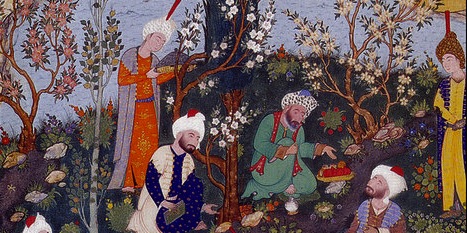As a student (and sometimes teacher) of foreign languages, I can attest to the difficulties that learners face in pursuit of that most elusive of second (third, fourth, fifth) language acquisition goals: sociolinguistic competence. Sociolinguistic competence, or the ability to use the appropriate linguistic skills (such as register) to negotiate social situations without causing offense or heaping embarrassment upon oneself, is a skill not easily developed in the artificial environment of the foreign language classroom. As far as I’m concerned, gaining sociolinguistic competence is like chasing the white dragon: the initial “high” of a successful social interaction in a foreign language imparts a feeling of intense accomplishment, but as the demands of the language increase, so do the frustrations and the breakdowns in communication. As a Persian language learner, I have experienced this challenge firsthand in the form of ta’arof.
To the uninitiated, ta’arof, the elaborate system of etiquette that governs the interpersonal relations between Persian speakers, may seem antiquated or even inefficient; to Persian speakers, however, it is a way to express gratitude and deference to a good host or hostess, and a means to demonstrate modesty and moderation. On a deeper level, ta’arof is a means through which interactions between people of differing socioeconomic stature are mediated in such a way that these differences are, at least temporarily, erased (I’m told, however, that this is dependent upon both parties being cognizant of each others’ socioeconomic status).
Ta’arof has a built-in set of phrases and specific conditions in which these phrases are used. The challenge for a student of Persian, let alone a non-Iranian student of Persian who did not grown up ta’arof-ing (like me), is knowing when to ta’arof and when to not. For example, some months ago I invited an Iranian friend (who may or may not be an editor of this blog) to my home and offered him something to drink. He refused my offer and I figured that was that. Big mistake. I later learned that my friend was in fact rather thirsty, but he, being the polite Iranian that he is, did not ask me again for something to slake this thirst. I was horrified to learn that a) I had been a less than stellar hostess, and b) that for all of the blood, sweat, and tears I had poured into learning Persian, I still lacked this very crucial component of sociolinguistic competence.
What is one to do when confronted with such a deficit in their etiquette be farsi? Should students of Persian just ignore ta’arof and go on their merry way, committing social faux pas at every turn? Or should ta’arof be taught and re-taught through social interaction, until it becomes a skill in the linguistic repertoire? The way I see it, I cannot possibly gain mastery of a language without paying attention to its sociolinguistic components. How can I expect to communicate with ease in another language if I have no clue how to properly interact with my audience, or how many times I should either offer or refuse something?
The best possible approach to mastering ta’arof as a Persian language student is to look at it deeper than the surface level of people being polite to one another. Ta’arof should be emphasized as a means of communication in which both parties achieve some kind of parity, and demonstrate respect for one another, regardless of social class.
My struggle with mastering ta’arof will no doubt continue well into the future, but at this point I hope that I have a sufficient enough grasp of it (learned through past mistakes) to avoid creating a really awkward situation.













1 comment